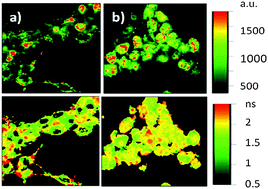Fluorescence lifetime imaging of physiological free Cu(ii) levels in live cells with a Cu(ii)-selective carbonic anhydrase-based biosensor†‡
Abstract
Copper is a required trace element that plays key roles in a number of human enzymes, such that copper deficiency or genetic defects in copper transport lead to serious or fatal disease. Rae, et al., had famously predicted that free copper ion levels in the cell cytoplasm were extremely low, typically too low to be observable. We recently developed a variant of human apocarbonic anhydrase II for sensing metal ions that exhibits 25-fold better selectivity for Cu(II) over Zn(II) than the wild type protein, enabling us to accurately measure Cu(II) in the presence of ordinary cellular (picomolar) concentrations of free zinc. We inserted a fluorescent labeled Cu(II)-specific variant of human apocarbonic anhydrase into PC-12 cells and found that the levels are indeed extremely low (in the femtomolar range). We imaged the free Cu(II) levels in living cells by means of frequency-domain fluorescence lifetime microscopy. Implications of this finding are discussed.


 Please wait while we load your content...
Please wait while we load your content...